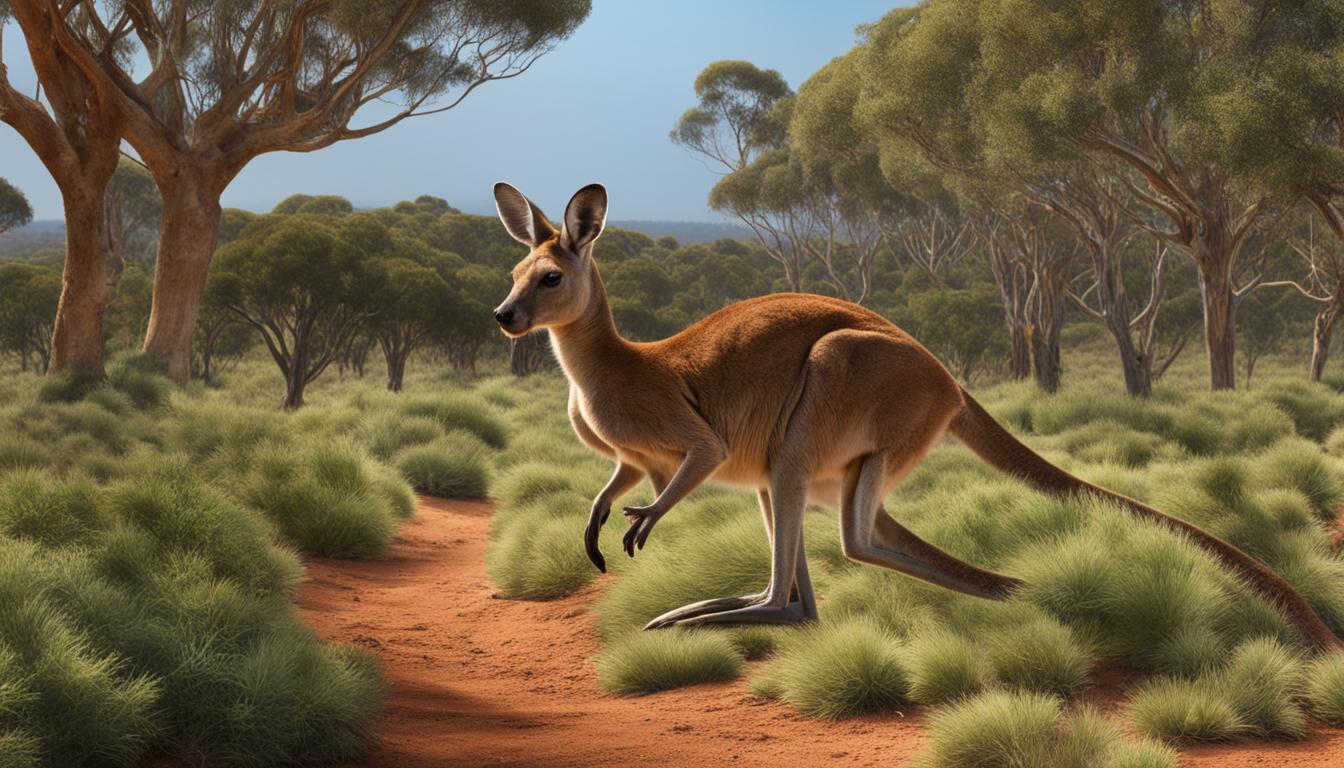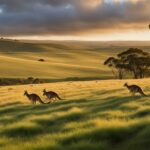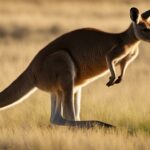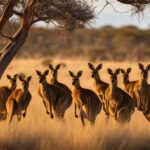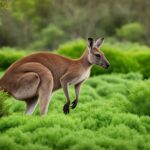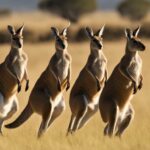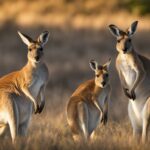Have you ever wondered how long kangaroos live in their natural habitat? In this article, we will explore the average lifespan of kangaroos and the factors that can affect it. Whether you’re curious about the lifespan of kangaroos or researching for educational purposes, this information will provide you with valuable insights.
Kangaroo lifespan, average kangaroo lifespan, and the lifespan of kangaroos are the keywords we will be focusing on in this section. So, let’s dive into the details and discover more about these fascinating creatures.
Factors Affecting Kangaroo Lifespan
The lifespan of kangaroos can be influenced by various factors that impact their overall health and well-being. These factors can determine whether they live a shorter or longer life in both the wild and captivity. Understanding these factors is crucial for conservation efforts and ensuring the longevity of kangaroo populations.
One of the key factors affecting kangaroo lifespan is the availability of food and water. Kangaroos primarily feed on vegetation, and during periods of drought or habitat loss, their food sources become scarce. This can lead to malnourishment, causing weakened immune systems and increasing their susceptibility to diseases.
Another significant factor is the presence of natural predators. In the wild, kangaroos face the threat of predation from animals like dingoes. Predators can cause stress and anxiety among kangaroos, leading to a shorter lifespan due to heightened levels of cortisol and other stress-related hormones.
Additionally, environmental conditions such as heat and drought can have a detrimental effect on kangaroo lifespan. Extreme temperatures and dehydration can cause physiological stress, leading to organ damage and reduced life expectancy. Climate change and habitat destruction further exacerbate these challenges, making it essential to protect and preserve kangaroo habitats.
The Impact of Human Activities
Human activities also play a significant role in affecting kangaroo lifespan. Deforestation, urbanization, and land development can result in the destruction of kangaroo habitats, limiting their access to food, water, and shelter. Encroachment into their natural environments can lead to increased encounters with vehicles, resulting in fatal accidents.
However, it is worth noting that kangaroos can have a longer lifespan in captivity. In controlled environments like wildlife sanctuaries and zoos, they are not exposed to the same threats as their wild counterparts. Captive kangaroos receive regular veterinary care, proper nutrition, and protection from predators, allowing them to live longer and healthier lives.
| Factors Affecting Kangaroo Lifespan | Description |
|---|---|
| Availability of Food and Water | Limited access to food and water due to drought or habitat loss can lead to malnourishment and weakened immune systems. |
| Presence of Natural Predators | Predation from animals like dingoes can cause stress and anxiety, impacting kangaroo lifespan. |
| Environmental Conditions | Extreme temperatures, heatwaves, and dehydration can result in organ damage and reduced life expectancy. |
| Human Activities | Deforestation, habitat destruction, and encounters with vehicles pose significant threats to kangaroos in the wild. |
| Captivity | Kangaroos in captivity benefit from regular veterinary care, proper nutrition, and protection from predators, leading to longer lifespans. |
Kangaroo Lifespan in Captivity
When it comes to the lifespan of kangaroos, being in captivity can significantly extend their years. In captivity, kangaroos can live beyond 20 years, surpassing their wild counterparts by a considerable margin. The absence of natural predators and a consistent food supply are key factors contributing to their extended lifespan.
Kangaroos living in captivity receive proper care and nutrition, which can greatly impact their longevity. They are protected from the dangers and stresses of the wild, allowing them to live healthier lives. Captive kangaroos experience reduced risks of hunger, dehydration, and exposure to extreme weather conditions, which are common challenges faced by kangaroos in the wild.
Comparison: Kangaroo Lifespan in the Wild vs. Captivity
The table below presents a comparison of the lifespan of kangaroos in the wild and in captivity:
| Kangaroo Species | Wild Lifespan | Captive Lifespan |
|---|---|---|
| Red Kangaroo | 16 years | Up to 22 years |
| Antilopine Kangaroo | N/A | Up to 20 years |
| Eastern Grey Kangaroo | Up to 12 years | Up to 20 years |
| Western Grey Kangaroo | 9 to 13 years | Up to 20 years |
As seen in the table, the lifespan of kangaroos can differ slightly depending on the species. However, regardless of the species, kangaroos in captivity generally have a longer lifespan compared to their wild counterparts. The table also highlights the substantial increase in lifespan for certain species, such as the red kangaroo, which can live up to 6 years longer in captivity.
Overall, it is evident that kangaroos thrive in captivity due to the favorable conditions provided, allowing them to live longer and healthier lives. While conservation efforts are crucial to preserving kangaroos in their natural habitats, the role of well-managed captive facilities cannot be overlooked in ensuring the long-term survival and well-being of these unique marsupials.
Kangaroo Lifespan by Species
When it comes to the lifespan of kangaroos, different species have slight variations. Below, you can find a breakdown of the average lifespans for some common kangaroo species:
| Kangaroo Species | Wild Lifespan | Captivity Lifespan |
|---|---|---|
| Antilopine Kangaroo | Approximately 16 years | N/A |
| Eastern Grey Kangaroo | Up to 12 years | Up to 20 years |
| Western Grey Kangaroo | 9 to 13 years | Up to 20 years |
| Red Kangaroo | Approximately 16 years | Up to 22 years |
The antilopine kangaroo has an average wild lifespan of around 16 years. Eastern grey kangaroos can live up to 12 years in the wild, while in captivity, they have the potential to reach up to 20 years. Western grey kangaroos have a similar wild lifespan of 9 to 13 years, with a maximum lifespan of 20 years in captivity. The red kangaroo, the largest marsupial, has an average lifespan of approximately 16 years in the wild and can live up to 22 years in captivity.
“The lifespan of kangaroos can vary slightly depending on the species.”
These figures provide useful insight into the different lifespans across kangaroo species. It’s important to note that these lifespans are averages and can vary depending on various factors such as environmental conditions, access to resources, and threats from predators. Understanding the lifespans of different kangaroo species can contribute to efforts aimed at their conservation and protection.
Kangaroo Lifespan by Species – Key Takeaways
- Antilopine kangaroos have an average wild lifespan of around 16 years.
- Eastern grey kangaroos can live up to 12 years in the wild and up to 20 years in captivity.
- Western grey kangaroos have a wild lifespan of 9 to 13 years and can live up to 20 years in captivity.
- The red kangaroo, the largest marsupial, has an average wild lifespan of approximately 16 years and can live up to 22 years in captivity.
Kangaroo Lifespan Comparison: Wild vs. Captivity
Kangaroos have a remarkable ability to adapt to various environments, but their lifespan can differ significantly depending on whether they live in the wild or in captivity. In the wild, kangaroos face numerous challenges that can impact their longevity, including droughts, heatwaves, and habitat loss. On the other hand, kangaroos in captivity enjoy a more controlled environment with fewer natural predators and a consistent food supply, allowing them to live longer and healthier lives.
Table:
| Species | Wild Lifespan | Captivity Lifespan |
|---|---|---|
| Red Kangaroo | Up to 16 years | Up to 22 years |
| Eastern Grey Kangaroo | Up to 12 years | Up to 20 years |
| Western Grey Kangaroo | 9-13 years | Up to 20 years |
As shown in the table, different kangaroo species exhibit variations in their lifespan. The red kangaroo, which is the largest marsupial, has a lifespan of up to 16 years in the wild and can live up to 22 years in captivity. Eastern grey kangaroos can live up to 12 years in the wild, but with proper care in captivity, they can reach up to 20 years. Similarly, western grey kangaroos have a lifespan of 9 to 13 years in the wild and can live up to 20 years in captivity.
It is important to note that while kangaroos in captivity generally have longer lifespans, their natural behaviors and instincts may be compromised to some extent. However, reputable zoos and wildlife sanctuaries prioritize providing an environment that mimics the kangaroos’ natural habitat as closely as possible, ensuring their physical and mental well-being.
Conclusion
In conclusion, the average lifespan of kangaroos in the wild is up to 23 years. However, factors such as heat, drought, and habitat loss can shorten their longevity. To ensure the survival of these iconic marsupials, it is crucial to protect their natural habitats and address the threats they face.
When kangaroos are kept in captivity, they can live longer lives, often surpassing 20 years. The absence of natural predators and access to a consistent food supply contribute to their extended lifespan. Proper care and nutrition provided in captivity play a significant role in promoting their overall well-being.
It is worth noting that different kangaroo species have slight differences in lifespan. The red kangaroo, the largest marsupial, has a lifespan of around 16 years in the wild and up to 22 years in captivity. Understanding these variations can help in developing targeted conservation efforts.
Preserving the natural habitats of kangaroos is essential for their survival and allowing them to live their full lifespan. By addressing the threats they face and promoting conservation efforts, we can contribute to the long-term well-being of these remarkable creatures.
What is the average lifespan of kangaroos in their natural habitats?
The average lifespan of kangaroos in their natural habitats, where kangaroos are found, is typically around 6 to 8 years. However, in captivity, they can live up to 20 years or more. Various factors, including predation, availability of resources, and disease, contribute to the relatively shorter lifespan in the wild.
FAQ
What is the average lifespan of a kangaroo in the wild?
The average lifespan of a kangaroo in the wild is up to 23 years.
What factors affect kangaroo lifespan?
Factors such as drought, heat, and habitat loss can impact the longevity of kangaroos.
How long do kangaroos live in captivity?
Kangaroos can live beyond 20 years in captivity, thanks to the absence of natural predators and proper care.
What is the lifespan of kangaroos by species?
The lifespan can vary slightly depending on the species. The red kangaroo has a lifespan of around 16 years in the wild and up to 22 years in captivity. The antilopine kangaroo has a lifespan of around 16 years. Eastern grey kangaroos can live up to 12 years in the wild, while in captivity, they can reach 20 years. Western grey kangaroos have a similar lifespan of 9 to 13 years in the wild and can also live up to 20 years in captivity.
How does the lifespan of kangaroos in the wild compare to their lifespan in captivity?
In the wild, the average lifespan of a kangaroo is up to 23 years, while kangaroos in captivity can live beyond 20 years.

